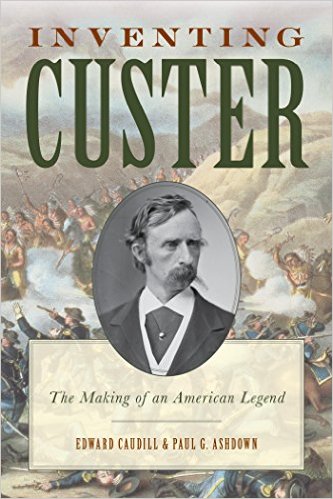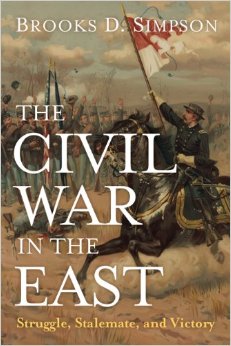Inventing Custer: The Making of An American Legend by Edward Caudill and Paul G. Ashdown. Rowman & Littlefield, 2015. Cloth, ISBN: 978-1442251861. $40.00.
 In America’s popular consciousness, the name George Armstrong Custer often evokes images of a daring, charismatic, golden-haired cavalry commander, in a fringed, buckskin coat, trying to fend off attacking warriors in a futile effort at the Little Big Horn. While the image of “Custer’s Last Stand” is regarded in popular lore as Custer’s iconic moment and has been the subject of hundreds of books, the obsession with his cataclysmic defeat has created a dilemma in Custer scholarship. Because so many have been enamored with the mystique of the Little Big Horn, significant aspects of Custer’s story—his early life, Civil War career, and an understanding of how that romantic legacy was created and evolved—has suffered as a result. In 1983, Gregory Urwin tried to remedy part of this deficiency with his now classic biography Custer Victorious: The Civil War Battles of General George Armstrong Custer. Now, more than three decades after Urwin’s study, Edward Caudill and Paul Ashdown’s study of Custer’s life and the creation of his legacy offers a significant contribution to Custer literature.
In America’s popular consciousness, the name George Armstrong Custer often evokes images of a daring, charismatic, golden-haired cavalry commander, in a fringed, buckskin coat, trying to fend off attacking warriors in a futile effort at the Little Big Horn. While the image of “Custer’s Last Stand” is regarded in popular lore as Custer’s iconic moment and has been the subject of hundreds of books, the obsession with his cataclysmic defeat has created a dilemma in Custer scholarship. Because so many have been enamored with the mystique of the Little Big Horn, significant aspects of Custer’s story—his early life, Civil War career, and an understanding of how that romantic legacy was created and evolved—has suffered as a result. In 1983, Gregory Urwin tried to remedy part of this deficiency with his now classic biography Custer Victorious: The Civil War Battles of General George Armstrong Custer. Now, more than three decades after Urwin’s study, Edward Caudill and Paul Ashdown’s study of Custer’s life and the creation of his legacy offers a significant contribution to Custer literature.
Caudill and Ashdown, professors of journalism and electronic media at the University of Tennessee, have relied on extensive published primary and secondary sources to produce a volume that is part biography, part historiography, and part memory study. Throughout the book, the authors do a commendable job of recounting Custer’s life—his birth in New Rumley, Ohio, time as a cadet at West Point, career during the Civil War, campaigns during the Indian Wars, and annihilation at Little Big Horn in 1876.
For Civil War historians, this book’s importance rests in several areas. First, Caudill and Ashdown offer an extensive treatment of Custer’s Civil War years, something that the authors correctly assert is oftentimes treated “as a prelude to the Little Bighorn” rather than as the most formative period in Custer’s military life (5), In addition to offering a sharp analysis of Custer’s important roles at engagements such as Brandy Station, Gettysburg, and Tom’s Brook, the authors focus on the less romantic moments in Custer’s Civil War career that arguably had a greater impact on his maturation; chief among them are Custer’s service on General George McClellan’s staff in 1862.
The time Custer spent in McClellan’s shadow taught him valuable lessons about such things as communication, logistics, and organization. Although a significant moment in Custer’s evolution as an officer, the authors rightly observe that since this staff experience did nothing to add to the Custer mythos, most historians have simply ignored it. But the authors present compelling evidence that Custer’s relationship with McClellan became a crucial one in the formation of Custer’s legendary status. The authors state that during the spring of 1863, when McClellan summoned Custer to New York to assist in writing campaign and battle reports—“a defense of his leadership as commander of the Army of the Potomac”— Custer learned a great deal about how to shape one’s history (63).
Beyond Caudill’s and Ashdown’s insightful analysis of Custer’s Civil War service, historians of our American Iliad will find that the authors parse a great deal of historiography throughout their superb book—illustrating the roles that historians have played in adding to Custer’s legend. The authors have found that some historians over time have embellished various tales of Custer’s Civil War career, such as the story first relayed by Frederick Whittaker’s 1876 biography A Complete Life of General George A. Custer (which depicted Custer as disgruntled by the prospect of emancipation and McClellan’s removal from command), to Stephen Ambrose’s and Robert Utley’s portrayal of events, which included Custer threatening to mutiny and to stage a coup d’état to oust President Abraham Lincoln. Additionally, the authors contend that historians such as Tom Carhart—who claimed “that Custer saved the Union at Gettysburg”—only further exaggerate an overly romanticized Custer (90). While no one takes issue with the “bravery and audacity” Custer displayed during the fighting in the East Cavalry Field, Caudill and Ashdown simply believe that Carhart’s overblown assertion is “wrong” and only adds “more fuel to the Custer myth”—a conclusion that many historians would support (90).
Of course, Caudill and Ashdown carefully illustrate that although historians might be culpable in exaggerating Custer’s image, they are not at fault for creating it. From Custer’s personal writings to articles he penned for the Galaxy, the authors lucidly show that the initial architect of Custer’s legend was the man himself. After Custer set his legacy’s cornerstone, an army of journalists, veterans, and of course his wife, Libbie—the one person who did more after Custer’s death in 1876 to elevate his status than anyone—continued to build Custer’s larger-than-life reputation.
While Caudill and Ashdown are careful to consider the people who shaped Custer’s image, they are also astute in their observations that the time in which people wrote about Custer or made films related to Custer influenced their opinions about him. The authors carefully chart how Custer’s heroic image remained untarnished until the 1920s, a moment which witnessed a “rising tide of modernism” when more Americans looked critically at “American traditions and icons.” They also assess the 1950s, when authors such as Quentin Reynolds, the author of a children’s biography, portrayed Custer as a young, heroic man in an attempt to inculcate a sense of patriotism into America’s youth. The hope was that they might be inspired to become military heroes in the crusade to destroy communist regimes (260).
There is little to criticize in this well-balanced, prodigiously researched, and masterfully crafted study. This book is not only essential reading for Custer aficionados, but for anyone who seeks to understand how a historical legacy is created, manipulated, and changes with the evolving moods of an ever-changing nation.
Jonathan A. Noyalas is Assistant Professor of History & Director of the Center for Civil War History at Lord Fairfax Community College in Middletown, Virginia.
